Archivo de noticias y eventos
751 - 800 de un total de 2402
También puede acceder a la lista de noticias publicadas en los medios relacionadas con el Instituto de Astrofísica de Andalucía - CSIC.
Pages

|
22/10/2019 - 12:30
Data mining Gaia DR2: the quest for Pre-Main Sequence Stars (and their discs) As the birth-sites of planets, protoplanetary discs have become the object of intense study during the last years. Constraining their typical lifetimes, masses and/or sizes is crucial to understand the process of planet formation. These objects are a natural by-product of early stellar evolution, and therefore a high fraction of Pre-Main Sequence Stars (PMS) are surrounded by a protoplanetary disc. The current census of PMS (and discs) has been... Dr. Héctor Cánovas |
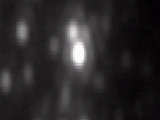
|
19/09/2019
El agujero negro central de nuestra galaxia incrementa su actividad. El agujero negro central de nuestra galaxia incrementa su actividad. |
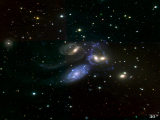
|
19/09/2019
Redescubriendo el "Quinteto de Stephan" Un trabajo de investigadores del IAA-CSIC ofrece nuevos resultados sobre el "Quinteto de Stephan" uno de los sistemas compactos de galaxias más paradigmáticos. |

|
02/12/2019 - 12:30
Molecular outflows: evolution, structure and angular momentum We present a theoretical model in order to explain the formation and the evolution of the molecular outflows associated to protostars. In this model, we assume that the molecular outflow is a thin shell formed by the interaction between a fast stellar wind and a rotating cloud envelope in gravitational collapse. We obtain a set of partial differential equations, these equations are space and time dependent, and describe the physical properties... Dr. Alejandro López Vázquez |

|
23/10/2019 - 12:30
Molecular spectroscopy at high resolution for everyone Molecular observations at high resolution is being revolutionized by the success of ALMA and the upcoming advent of SKA. In this talk I will explain the recent progress in the field of molecular observations in the central regions of galaxies and the big steps that we are currently making in the use and understanding of molecular tracers as a proxy to buried physical processes in active galaxies. I will show some preliminary results from the... Dr. Sergio Martín Ruiz |

|
19/09/2019 - 12:30
JPAS: A survey for Galaxy Evolution studies JPAS is a survey of 5000-8000 deg2 of the sky with 56 narrow band filters in the Observatory of Javalabre. This survey is very relevant for Cosmology, Galaxy Evolution and Stellar Physics studies. In January 2020, JPAS with its JPCam will have the first light. However, the project has already taken data of 2 deg2 of the sky in two cosmological fields (AEGIS and JWST-NEP). The 2-4th of December will be the first data release (DR1) during the RIA... Dr. Rosa González Delgado |

|
10/09/2019
Vuelve la Noche Europea de L@s Investigador@s El IAA-CSIC participa un año más en La Noche Europea de L@s Investigador@s |

|
09/09/2019
El Instituto de Astrofísica de Andalucía (IAA-CSIC) recibe el distintivo de Centro de Excelencia Severo Ochoa Hoy se celebra en Madrid la entrega oficial de estos distintivos a la excelencia científica, que dotan a los centros con un millón de euros anual durante cuatro años |
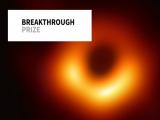
|
06/09/2019
Investigadores del IAA, en los “Óscar de la ciencia” El Premio Breakthrough en Física Fundamental, dotado con tres millones de dólares, ha recaído en la colaboración internacional Telescopio Horizonte de Sucesos (EHT), que obtuvo la primera imagen de un agujero negro. Dos investigadores del Instituto de Astrofísica de Andalucía (IAA-CSIC) participan en la colaboración, que agrupa a 347 investigadores |

|
28/11/2019 - 12:30
SO-IAA Colloquium: Recent advances about the exoplanetary exospheres The upper atmosphere of a planet plays a key role at protecting the lower altitudes from the effects of energetic stellar EUV and soft X-ray photons and keV-energy precipitating particles. Through a variety of transport processes, the upper atmosphere also participates in the net loss of a planet’s bulk composition into space. As such, the physics and chemistry occurring in the upper atmosphere influence the evolution of a planet over its... Antonio García Muñoz |
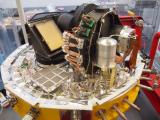
|
15/08/2019
Una tesis sobre la cámara PANIC obtiene el premio SEA a la mejor tesis doctoral española en instrumentación PANIC es una cámara infrarroja de gran campo de visión desarrollada conjuntamente por el Max-Planck-Institut für Astronomie (MPIA) y el Instituto de Astrofísica de Andalucía (IAA-CSIC) |

|
07/11/2019 - 12:30
SO-IAA Colloquium: Characterization of (exo)Planetary Atmospheres Characterization of planetary atmospheres has always been a challenge. While the next generation of facilities, such as ELT, JWST, and ARIEL, will improve our understanding of planetary atmospheres, the number of well-characterized exoplanet atmospheres is expected to remain limited. Large-scale simulations assist us with this shortcoming by predicting the diversity of the planetary atmospheres, connecting the spare observational measurements,... Dr. Karan Molaverdikhani |

|
03/10/2019 - 12:30
Some aspects of high precision machines for astronomical applications Cranfield Precision are not specialists in astronomy but their expertise in designing and building very precise special-purpose machines has contributed to several important astronomical projects. In this talk I will show several machines with astronomical applications and select some features of particular interest for discussion. Richard May-Miller |

|
05/09/2019 - 12:30
Broad line AGN in the MaNGA survey This talk presents a way to find Type I Active Galactic Nuclei in the MaNGA survey (Mapping Nerby Galaxies at Apache point observatory). The method is based on flux ratios between spectral regions where a broad line in emission is expected. Likewise, the spectroscopic analysis of 44 galaxies with nuclear activity is shown; as well as the estimation of the mass of supermassive black holes and the effect that the active nucleus has on... Dra. Alenka Negrete |

|
17/10/2019 - 12:30
SO-IAA Colloquium: What's is the metallicity of cool dwarf stars? Cool dwarfs are the most numerous stars in the Galaxy and they account for most of its baryonic mass. However, they are likely the least understood main sequence stars. Their complex atmospheres, due to their low temperatures and high surface gravities, have made their spectroscopic study a hard task. Until recently, their basic physical properties, such as radii and mass, were poorly constrained due to the lack of empirical data. Stellar... Bárbara Rojas-Ayala |
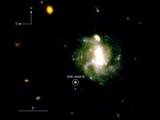
|
27/08/2019
Se detecta una lejana colisión estelar con el brillo de los metales preciosos Se halla, en los datos de una explosión de rayos gamma de 2016, una firma que coincide con la explosión productora de oro y platino observada en luz y ondas gravitatorias en 2017. Se confirma así que los elementos pesados se producen en las kilonovas, estallidos que resultan de la fusión de dos objetos muy compactos, como estrellas de neutrones o agujeros negros |

|
12/09/2019 - 12:30
Detection of Exocomets: The gaseous environment of Main-Sequence Stars Planetesimals and small solid bodies in general are key to understand the chemical and dynamical evolution of planetary systems. Direct detection outside the Solar System is still not feasible. However, indirect evidences of such bodies as dusty debris disks or the presence of large amounts of gas in the close-in surroundings of main-sequence stars have been collected for over 30 years now. Transient events observed as variable non-... Dr. Isabel Rebollido |
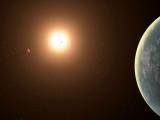
|
31/07/2019
Observaciones de satélite y desde tierra permiten hallar un trío planetario en una estrella cercana La combinación de datos del satélite TESS con los de varios instrumentos en tierra, entre ellos CARMENES, ha permitido detectar un sistema planetario múltiple en una estrella cercana. El trabajo, en el que participa el Instituto de Astrofísica de Andalucía (IAA-CSIC), abre la puerta al estudio en detalle de sistemas planetarios múltiples |

|
10/10/2019 - 12:30
THE INNER DEBRIS OF SN1987A: MOLECULAR AND DUST EMISSION The supernova SN1987A in the Large Magellanic Cloud, together with new instrumentation like ALMA, offers an unprecedented opportunity to tackle fundamental issues of supernova explosions. Large masses of molecules and dust have been formed in its inner debris over the last 25 years. Recently developed tomographic techniques have allowed to obtain 3D-images of its molecular emission. Also, high-resolution images of dust emission have recently... Prof. Jon Marcaide |
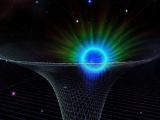
|
25/07/2019
La órbita de una estrella alrededor del agujero negro supermasivo de la Vía Láctea confirma la validez de la teoría de la relatividad de Einstein La estrella S2 dibuja una elipse en torno a Sagitario A*, el agujero negro del núcleo galáctico, y su seguimiento a lo largo de veintiséis años ha permitido estudiar la gravedad en entornos extremos. Investigadores del Instituto de Astrofísica de Andalucía (IAA-CSIC) participan en los resultados, que se publican en la revista Science |
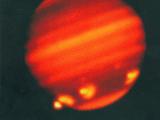
|
17/07/2019
25 aniversario del impacto del cometa Shoemaker-Levy 9 contra Júpiter Entre el 16 y el 24 de julio de 1994, el cometa Shoemaker-Levy 9 impactó contra Júpiter. Todos los observatorios del mundo estuvieron pendientes de este evento único en la historia. |

|
12/12/2019 - 12:30
NGC 7469 as seen by MEGARA: new results from high-resolution IFU spectroscopy In this talk I will present highlights from our recent work about the analysis of high-resolution (R ~ 20 000) GTC/MEGARA integral-field unit spectroscopic observations, obtained during the commissioning run, in the inner region (12.5arcsec×11.3arcsec) of the active galaxy NGC7469, at spatial scales of 0.62 arcsec. We explore the kinematics, dynamics, ionisation mechanisms and oxygen abundances of the ionised gas, by modelling the Hα-[NII]... Dr. Sara Cazzoli |

|
24/10/2019 - 12:30
ANALOGUES OF HIGH REDSHIFT GALAXIES: DISENTANGLING THE COMPLEXITY OF THE GREEN PEAS Young low-mass galaxies with extreme emission-line properties are ubiquitous at high redshift and they are believed to play a key role in cosmic reionisation and the early growth of galaxies at z>4-6. However, a detailed characterisation of their physical properties, critical for a better understanding of these two outstanding problems, is yet not possible. A unique population of lower-z analogues of these primeval systems, dubbed Green Pea (GP... Dr. Ricardo Amorin |
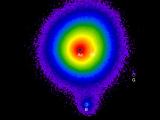
|
02/07/2019
Las estrellas muy masivas no se emparejan, sino que se agrupan en sistemas múltiples El proyecto MONOS, en el que participa el Instituto de Astrofísica de Andalucía (IAA-CSIC), estudia los sistemas binarios o múltiples formados por las estrellas más masivas. Emplea datos de sondeos y catálogos anteriores, así como observaciones con la cámara Astralux, instalada en el telescopio de 2.2 metros del Observatorio de Calar Alto |

|
14/11/2019 - 12:30
SO-IAA Colloquium: Outflows and their feedback effect in galaxies Galactic outflows are an essential component of galaxies' lifecycle. They regulate star formation and can even totally quench star formation in galaxies, hence transforming star forming galaxies into passive systems. I will review the properties of galactic outflows, their multi-phase nature, their driving mechanism, both in normal star forming galaxies and in galaxies hosting Active Galactic Nuclei, both in the local Universe and in... Dr. Roberto Maiolino |

|
12/11/2019 - 12:30
Study of the diversity of AGN dust models The dust component of active galactic nuclei (AGN) produces a broad infrared spectral energy distribution (SED), whose power and shape depends on the fraction of the source absorbed, and the geometry of the absorber respectively. This emitting region is expected to be concentrated within the inner ∼5 pc of the AGN which makes almost impossible to image it with the current instruments. The study the infrared SED by comparison between infrared AGN... Dr. Omaira González-Martín |

|
14/06/2019
Visitas al OSN y al IRAM 30 metros Los sábados 27 de julio, 3 y 24 de agosto. |
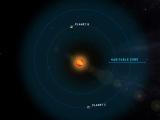
|
18/06/2019
CARMENES encuentra dos planetas templados de tipo terrestre alrededor de la estrella de Teegarden, una enana roja cercana CARMENES es un espectrógrafo visible e infrarrojo que opera desde el Observatorio de Calar Alto. Investigadores del Instituto de Astrofísica de Andalucía (IAA-CSIC) participan en el hallazgo, que ha contado con datos tomados desde distintos observatorios, entre ellos el Observatorio de Sierra Nevada (OSN) |

|
27/06/2019 - 19:00
Cambio climático en Marte Conferencia de divulgación sobre la atmósfera y la variabilidad climática del planeta rojo Francisco González Galindo |

|
07/06/2019
“¡España en SKA! “: la comunidad española define sus estrategias para obtener el mayor retorno científico del radiotelescopio SKA En junio de 2018 España se convertía en el undécimo miembro de la organización del SKA, que será la mayor infraestructura científica del planeta. La próxima semana se celebra en el Instituto de Astrofísica de Andalucía (CSIC) una reunión científica para establecer sinergias que permitan aprovechar al máximo sus posibilidades |
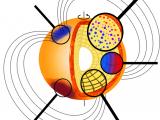
|
06/06/2019
Los primeros datos del satélite TESS arrojan luz sobre las estrellas roAp, las pulsantes extremas Los datos de TESS han permitido hallar cinco roAp, un tipo de estrellas raras que muestra rápidas pulsaciones, intensos campos magnéticos y una composición química peculiar |

|
19/11/2019 - 12:30
METIS instrument: the IMAGER and the SCAO METIS is one of the three first instruments for the European Extremely Large Telescope (ELT), Europe’s next-generation ground-based telescope for optical and infrared wavelengths which is currently under construction at the ESO site at Cerro Armazones in Chile. METIS is the Mid-infrared ELT Imager and Spectrograph. This instrument will offer imaging, coronagraphy and medium-resolution spectroscopy over the full wavelength range from 3 to 14... Dr. Concepción Cárdenas |

|
07/10/2019 - 12:30
SO Colloquia: FPGAs in space: current experiences, future challenges and opportunities FPGAs are key components in space equipment due to their versatility and performance to implement digital functions. They are embarked in satellites and used in many applications; such as observing the earth, provide telecommunications and navigation services as well as to contribute to science and explore the wider Universe. The FPGAs face very different conditions in space compared to the terrestrial applications, especially due to the... Merodio Codinachs |

|
25/06/2019 - 12:30
Properties of ionized outflows in MaNGA DR2 galaxies Feedback originated from star formation and AGN activity in galaxies can have a significant impact on their evolution. The action of feedback leads to several processes that might have a significant effect on the surrounding gas, for example by heating the system, halting or enhancing star formation, or enriching the interstellar medium. Constraining the incidence and properties of feedback events such as ionized outflows is therefore crucial to... Bruno Rodríguez Del Pino |

|
04/06/2019 - 12:30
Correlations between the size and the stellar population properties of quiescent galaxies During the last decades, many authors have put large efforts to shed light on the mechanisms responsible of the generalized growth in size of galaxies, as well as to disentangle the main “driver” of their stellar content. In our study, we aim at stating new constraints on the mechanisms that may drive the growth in size of massive galaxies through the study of the stellar population properties of quiescent galaxies within the stellar mass-... Dr. Luis Díaz García. |

|
23/05/2019
Se celebra el congreso del programa PIIISA 2018-19 El programa, concebido en el IAA, surgió con el fin de ofrecer al alumnado granadino de secundaria una forma moderna e innovadora de aprender e interaccionar con la ciencia |

|
18/06/2019 - 12:30
Oxygen Line Diagnostics in X-ray spectroscopy Line diagnostics is very important to understand the physics of astronomical sources. Taking advantage of oxygen line diagnostics in X-ray spectroscopy, I will show some of our research for both the moderate-resolution the high-resolution X-ray spectra based on the newly updated atomic database (ATOMDB). I will demonstrate its power for SgrA spectrum, HII regions, and some nearby galaxies. In addition, I will introduce related space mission... Dr. Li Ji |
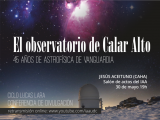
|
30/05/2019 - 19:00
El Observatorio de Calar Alto: 45 años de astrofísica de vanguardia Se han cumplido 45 años desde la fundación del Observatorio de Calar Alto. Un observatorio que, entre sus méritos, tiene el de haber sido uno de los principales motores del desarrollo de la astronomía en España y, por supuesto, uno de los fundamentos de la creación del Instituto de Astrofísica de Andalucía. Este año el observatorio pasa de ser Hispano-Alemán a ser totalmente Hispano, con la incorporación de la Junta de Andalucía como socio al... Jesús Aceituno |

|
24/05/2019 - 11:30
A prototype SKA Science Regional Centre at the IAA In this seminar we will describe our involvement in the design of the SRCs, how we are preparing for hosting an SRC at the IAA - one of the strategic objectives of the IAA Severo Ochoa programme - as well as potential benefits for the IAA and collaboration opportunities, such as the one already started with the PLATO team. We will conclude by illustrating the challenges associated with following Open Science principles with an example of their... Lourdes Verdes-Montenegro, Susana Sánchez, Michael G. Jones |

|
09/07/2019 - 12:30
The Orientation of the Collimated Outflows of Planetary Nebula: Independence Day The discovery of collimated outflows in planetary nebulae (PNe) has changed the paradigm of PN formation. They actively participate in the nebular shaping immediately before or while fast stellar winds and D-type ionization fronts shock and swept the nebular envelope. The general properties of collimated outflows of PNe cannot be studied because projection effects do not allow us to determine their space velocities and linear sizes. The large... Jackeline Suzett Rechy Garcia & Martin A. Guerrero |

|
17/05/2019 - 12:30
TIDES, PLANETARY WAVES, AND ATMOSPHERIC COUPLING A growing number of studies report linkages between unrelated stratospheric and upper atmospheric phenomena. For example, stratospheric warmings correlate with ionospheric perturbations, and with reductions in polar mesospheric cloud occurrence. Understanding these so-called teleconnections is important for prediction of the near-space environment, and interpreting global change proxies. Tides and planetary waves are important agents for... Dr. Ruth Lieberman |

|
19/06/2019 - 11:00
SO Colloquia: Searching extended line-emission objects in wide-field surveys: The IPHAS experience One of the problems we are facing in the study of evolved low- and intermediate-mass stars such as Planetary Nebulae (PNe) is the lack of completeness. Most known PNe belong to the bright or intermediate part of the luminosity function, leaving out those at the faint end. Any global chemical, kinematical, and physical analysis of the PN population is therefore biased. In 2003 the INT Photometric Halpha Survey started scanning the... Dra. Laurence Sabin |

|
13/06/2019 - 12:30
SO Colloquium: Back to Orion Orion is the massive star formation region closest to the Sun and in consequence it has been studied in detail. I will present three recent results from the IRyA group on this region. The first one is the ultraprecise determination of the distance to Orion using VLBI observations of stars with non-thermal emission. The second result is a study of the kinematics of the stars with either termal or non-thermal emission. Finally, we will focus on... Dr. Luis F. Rodríguez |
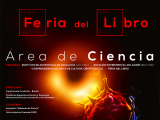
|
06/05/2019
La ciencia, de nuevo, en la Feria del Libro Programación de ciencia en la Feria del Libro 2019 de Granada |
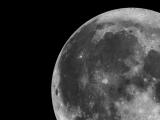
|
30/04/2019
Se detecta el choque de una roca contra la Luna durante un eclipse total El estudio de los impactos en la superficie lunar permite ajustar las predicciones de impactos en nuestro planeta |

|
07/06/2019 - 12:30
The Very Large Array Sky Survey (VLASS) and the next generation Very Large Array (ngVLA) The VLASS is part of a new generation of radio sky surveys. It covers the entire sky above -40 degrees declination. Observations started with the Karl G. Jansky Very Large Array in 2017 and the first epoch covering the entire survey area will be completed by July 2019. This will be followed by two more complete passes with an anticipated completion by 2024. In comparison to previous surveys, the observations are performed at 2-4 GHz and at... Dr. Frank Schinzel |

|
25/04/2019 - 19:00
La primera imagen de un agujero negro El Telescopio Horizonte de Sucesos (EHT por sus siglas en inglés), un telescopio de escala planetaria, constituido por ocho radiotelescopios y forjado gracias a una colaboración internacional, fue diseñado con el objetivo de capturar las primeras imágenes de agujeros negros. En una serie de conferencias de prensa internacionales simultáneas celebradas el pasado 10 de abril, investigadores del EHT revelaban que han tenido éxito y mostraban la... José Luis Gómez |

|
22/04/2019
El European Planetary Science Congress 2020 se celebrará en Granada Hoy se ha difundido, en el Ayuntamiento de Granada, la propuesta de investigadores del IAA, de la ESAC y del Palacio de Congresos para que la mayor reunión europea sobre ciencias planetarias se desarrolle en Granada |

|
03/05/2019 - 12:30
An ionised bubble before the epoch of re-ionisation In a search for Lyman Alpha sources around two spectroscopically confirmed star forming sources in the Subaru Deep Field, we have found some 45 low luminosity star forming galaxies. We find that these sources form a proto-cluster. Moreover, they reside in an ionised bubble of at least 12000 cMpc^3. Dr. Jose Miguel Rodriguez Espinosa |
